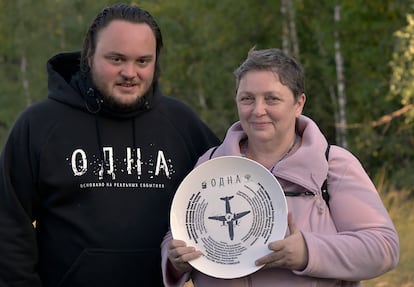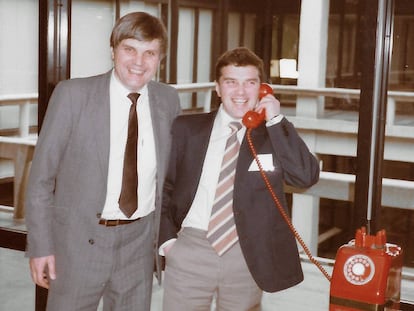Larisa Savitskaya: The sole survivor of an air disaster the USSR wanted to cover up
The 1981 plane crash claimed the lives of 37 people, but the Soviet government kept the incident classified. Now a new documentary and film are shedding light on what happened

Surviving a fall from 5,220 meters holding onto a fragment of an aircraft did not turn Larisa Savitskaya into a news headline, but rather an unwanted witness of an air disaster the USSR wanted to hide. On August 28, 1981, she and her husband were returning from their honeymoon on Aeroflot Flight 811 when the plane – an Antonov An-24 – collided mid-air with a Tupolev Tu-16K strategic bomber over Amur Oblast in the Soviet Union, which is now Russia.
Savitskaya, who was only 20 years old at the time, was the only survivor. Not only did she survive the eight-minute fall and crashing into trees, she also survived three days out in the open with her injuries. But Soviet authorities wanted to cover up her incredible story. Maintaining its tradition of secrecy and lack of transparency, it declared the incident classified. Savitskaya herself did not find out what had happened until the fall of the Soviet Union, 10 years later. Now, 40 years after the accident, a new documentary called Eight Minutes to the Ground is looking at this story of survival and secrecy – a tale that is also the focus of the Russian film Одна (or One), which will be released in Spain next year.
“They didn’t tell me anything. They only addressed my mother and told her: ‘Forget what happened,’” Savitskaya tells EL PAÍS. “My mother signed some documents. For 10 years, I didn’t know what had happened. Neither the number of passengers [who had died] nor any side of the story,” says the survivor, who, over time, has been able to recover from the trauma of that day and move on with her life. “Now I am good, I am a happy person,” she says.
The first article about the air disaster was published in 1985. It blamed the pilots and said that one of the aircraft was still flying. It was not until the 1990s that the investigation was declassified, and only then did the terrible mistakes of the Soviet air force come to light. The flight plan of the Tu-16K bomber crossed into the civilian route of the An-24 passenger aircraft. But the pilots of the bomber were not notified and the air controller at the military base who should have been supervising the Tu-16K did not use radar assistance to track the aircraft. Visibility was good beyond 10 kilometers, but the bomber collided with the passenger plane as it was mid-ascent. A total of 37 people died: 31 on board the AN-24 and the six crew members of the Tu-16K.
The crash occurred five years before Soviet leader Mikhail Gorbachev launched his campaign for glasnost – a drive to improve transparency in the murky Soviet administration. Despite this, secrecy within the powerful Russian military never disappeared, nor did the zeal for covering up its mistakes. The accident reports from the crash remained under lock and key and Gorbachev himself did not set a good example when it came to telling the truth. It took him one month to appear before the press after the Chernobyl nuclear disaster in 1986. Government secrecy in Russia continues even today: in 2019, while the city of Arkhangelsk expressed alarm about a spike in radiation levels, the Russian government remained silent for four days before revealing that there had been an explosion in a laboratory for new, nuclear-powered weapons.
They didn’t tell me anything. They only addressed my mother and told her, ‘Forget what happened’Plane crash survivor Larisa Savitskaya
“All for secrecy,” says Savitskaya, who points out that there was no coordination between military and civilian air traffic control at the time of the 1981 crash. “Several more cases like this happened in the country.” The sole survivor of the air disaster was paid ₽75 by Aeroflot, officially known as Russian Airlines. That was the equivalent of $110 or $330 (€287) by today’s standards. She was given another ₽150 for the death of her husband.
Larisa was introduced to her husband Vladimir Savitskaya by a mutual friend, and they began to date when she was studying at the Pedagogy Institute in Moscow. They married soon after and spent their honeymoon with Vladimir’s parents. When they boarded the plane in Komsomolsk-on-Amur, in the east of the USSR, to return to Blagoveshchensk, near the border with China, the aircraft was half empty and they chose seats at the back to be more comfortable. A flight attendant invited them to sit further up, but they refused and switched seats with other passengers who did want to be closer to the front. Savitskaya would later see her original seat fly off during the accident.
“I woke up in the aisle,” she says. The collision with the bomber had torn off both of the plane’s wings and some of the aircraft itself. The part of the plane she was in began to turn but did not tip over. Savitskaya returned to her seat and buckled her seatbelt. Vladimir was in the seat beside her. “I knew at that moment that my husband had died. He had blood on his head, on his suit…” she says.
The passenger plane began to break apart as it plummeted to the ground. Due to the decompression, it was extremely cold – dozens of degrees below zero. Savitskaya was conscious of everything. She saw the last moments of several passengers. “People were screaming,” she says. She held on tight to her seat as best she could, as it started to come loose from the floor. Her head filled with images of a film she had seen with her husband the year before, Miracles Still Happen (1974), where the protagonist saves herself by doing the same thing as Savitskaya. Luckily, the birch trees softened the blow of the impact.
“There are things you don’t forget,” says Savitskaya today. “It doesn’t matter how much I have tried, the plane accident will always be with me.” After hitting the ground, she woke up in the middle of the woods. She had fractures to her arms, ribs and five points in her spinal cord, and she had broken her teeth. The snow falling around her turned the forest into a dream-like landscape, one which held the body of her dead husband.
It doesn’t matter how much I have tried, the plane accident will always be with mePlane crash survivor Larisa Savitskaya
“I didn’t know where to go, I was surrounded by trees. It was terribly cold and it was raining quite a bit. I wanted to sleep but I couldn’t because of the pain,” recalls Savitskaya, who decided to wait for the rescue team. She covered herself in blankets she found among the wreckage and used plastic to protect herself from mosquitoes. To quench her thirst, she drank from a puddle. “I was soaked, I only wanted to get warm,” she says. A helicopter flew over the area and she tried to signal it, but no one came to her aid – they had mistaken her with some geologists who were working in the region. On the third day, she lost hope of being found, and in her weakened state, began to walk. She had not gone very far when she was at last discovered by rescuers. The next thing she remembers is waking up in a hospital.
After the accident, she had to remain silent. She also received no psychological help. “That concept didn’t exist,” Savitskaya explains. “Who helps you in this type of situation? Mom and dad. When I moved to Moscow to learn psychophysiology, I studied myself. I was able to help myself.”
Savitskaya has never worked as a psychologist with other victims of accidents, but her experience with post-traumatic stress has helped her to support the veterans of the Soviet-Afghan War (1979-1989). “They have a similar mental state,” she says. “Understanding that I was not the only one, that more people have survived similar things, helped me.”
Savitskaya was able to start her life again after the crash. When she looks around her now, she sees “a loving husband, a job, a son and a granddaughter.” What’s more, the accident hasn’t made her afraid of flying: “Lightning doesn’t strike twice in the same place – that phrase applies to me.”
Tu suscripción se está usando en otro dispositivo
¿Quieres añadir otro usuario a tu suscripción?
Si continúas leyendo en este dispositivo, no se podrá leer en el otro.
FlechaTu suscripción se está usando en otro dispositivo y solo puedes acceder a EL PAÍS desde un dispositivo a la vez.
Si quieres compartir tu cuenta, cambia tu suscripción a la modalidad Premium, así podrás añadir otro usuario. Cada uno accederá con su propia cuenta de email, lo que os permitirá personalizar vuestra experiencia en EL PAÍS.
¿Tienes una suscripción de empresa? Accede aquí para contratar más cuentas.
En el caso de no saber quién está usando tu cuenta, te recomendamos cambiar tu contraseña aquí.
Si decides continuar compartiendo tu cuenta, este mensaje se mostrará en tu dispositivo y en el de la otra persona que está usando tu cuenta de forma indefinida, afectando a tu experiencia de lectura. Puedes consultar aquí los términos y condiciones de la suscripción digital.
More information
Archived In
Últimas noticias
Maduro pleads not guilty before the federal court in New York: ‘I am still the president of Venezuela’
A new test can detect Alzheimer’s from a finger prick
UN team enters Sudanese city of El Fasher after paramilitary massacre: ‘It’s like a ghost town’
A recipe for resistance: Indigenous peoples politicize their struggles from the kitchen
Most viewed
- Gilles Lipovetsky: ‘If you want to live better and fall in love, take Prozac, don’t look to philosophy’
- Alain Aspect, Nobel laureate in physics: ‘Einstein was so smart that he would have had to recognize quantum entanglement’
- Alvin Hellerstein, a 92-year-old judge appointed by Bill Clinton, to preside over Maduro’s trial in New York
- Why oil has been at the center of Venezuela-US conflicts for decades
- Cuba confirms death of 32 of its citizens in the US attack against Venezuela











































